Page 2782 of 3229
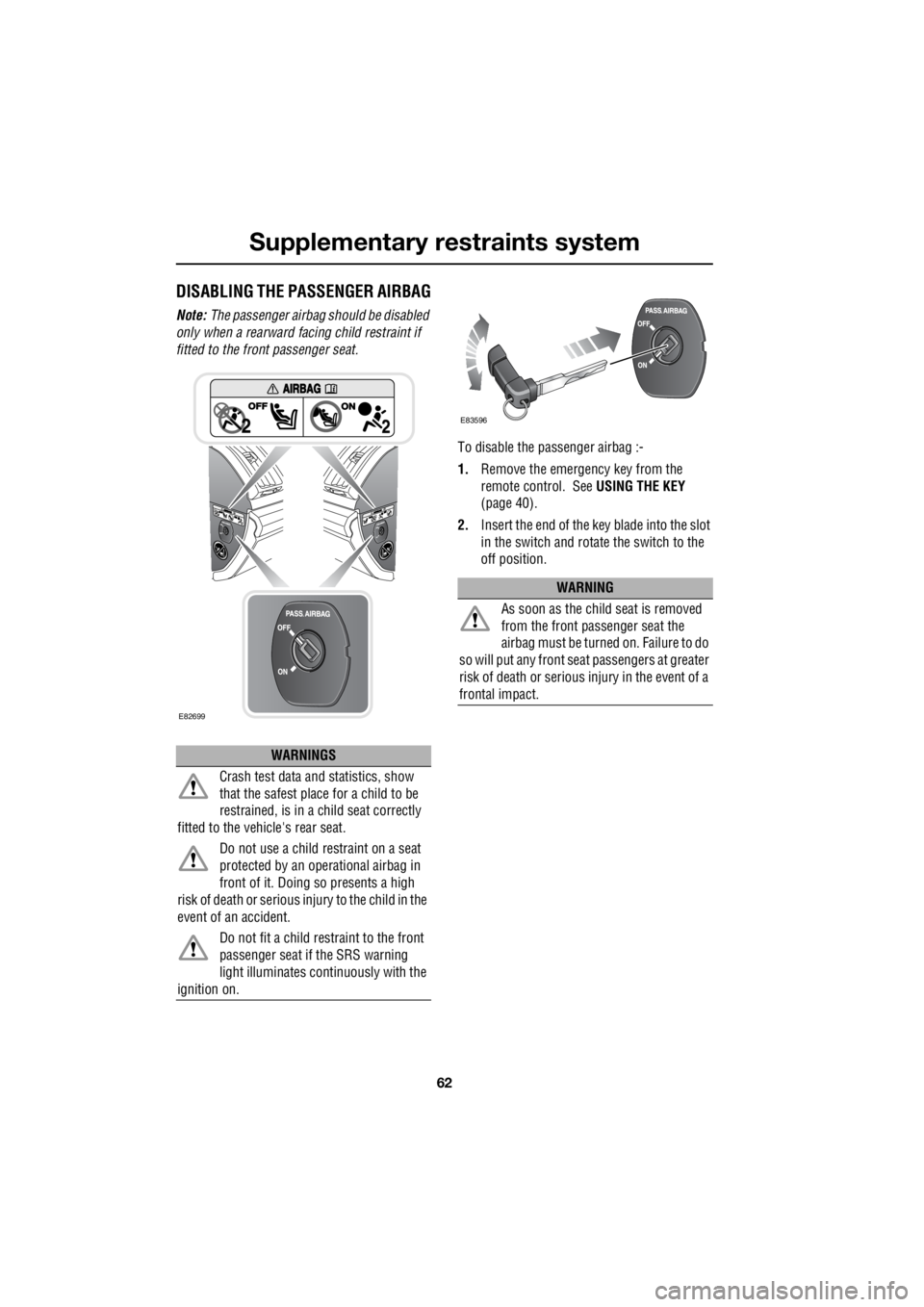
Supplementary restraints system
62
L
DISABLING THE PASSENGER AIRBAG
Note: The passenger airbag should be disabled
only when a rearward fa cing child restraint if
fitted to the front passenger seat.
To disable the passenger airbag :-
1. Remove the emergency key from the
remote control. See USING THE KEY
(page 40).
2. Insert the end of the key blade into the slot
in the switch and rotate the switch to the
off position.
WARNINGS
Crash test data and statistics, show
that the safest place for a child to be
restrained, is in a child seat correctly
fitted to the vehicle's rear seat.
Do not use a child restraint on a seat
protected by an ope rational airbag in
front of it. Doing so presents a high
risk of death or serious injury to the child in the
event of an accident.
Do not fit a child restraint to the front
passenger seat if the SRS warning
light illuminates co ntinuously with the
ignition on.
E82699
WARNING
As soon as the child seat is removed
from the front passenger seat the
airbag must be turned on. Failure to do
so will put any front seat passengers at greater
risk of death or serious injury in the event of a
frontal impact.
E83596
Page 2783 of 3229
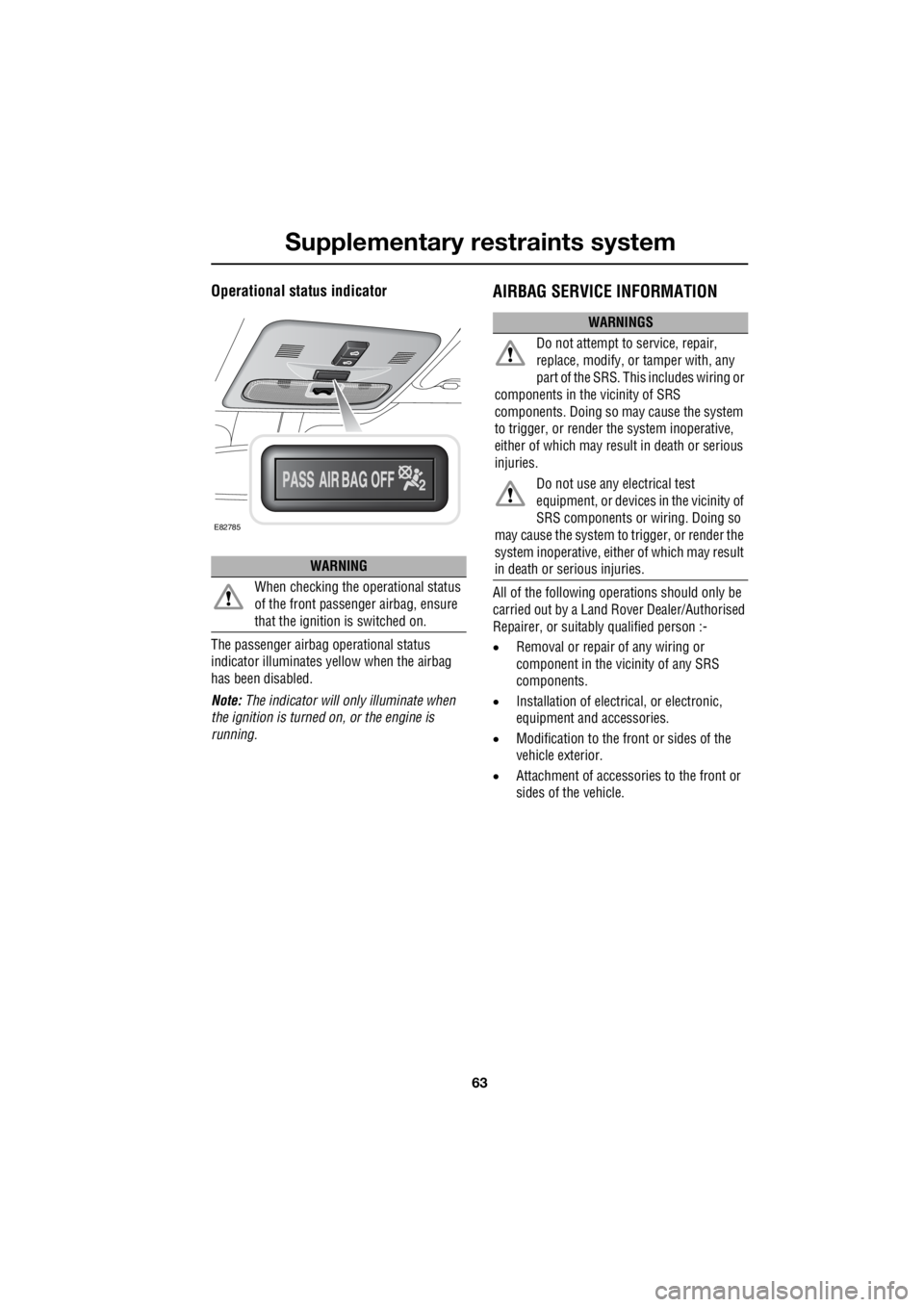
63
Supplementary restraints system
R
Operational status indicator
The passenger airbag operational status
indicator illuminates yellow when the airbag
has been disabled.
Note: The indicator will on ly illuminate when
the ignition is turned on, or the engine is
running.
AIRBAG SERVICE INFORMATION
All of the following opera tions should only be
carried out by a Land Rover Dealer/Authorised
Repairer, or suitably qualified person :-
• Removal or repair of any wiring or
component in the vicinity of any SRS
components.
• Installation of electr ical, or electronic,
equipment and accessories.
• Modification to the front or sides of the
vehicle exterior.
• Attachment of accessor ies to the front or
sides of the vehicle.
WARNING
When checking the operational status
of the front passenger airbag, ensure
that the ignition is switched on.
E82785
WARNINGS
Do not attempt to service, repair,
replace, modify, or tamper with, any
part of the SRS. Thi s includes wiring or
components in the vicinity of SRS
components. Doing so may cause the system
to trigger, or render the system inoperative,
either of which may resu lt in death or serious
injuries.
Do not use any electrical test
equipment, or devices in the vicinity of
SRS components or wiring. Doing so
may cause the system to trigger, or render the
system inoperative , either of which may result
in death or serious injuries.
Page 2792 of 3229
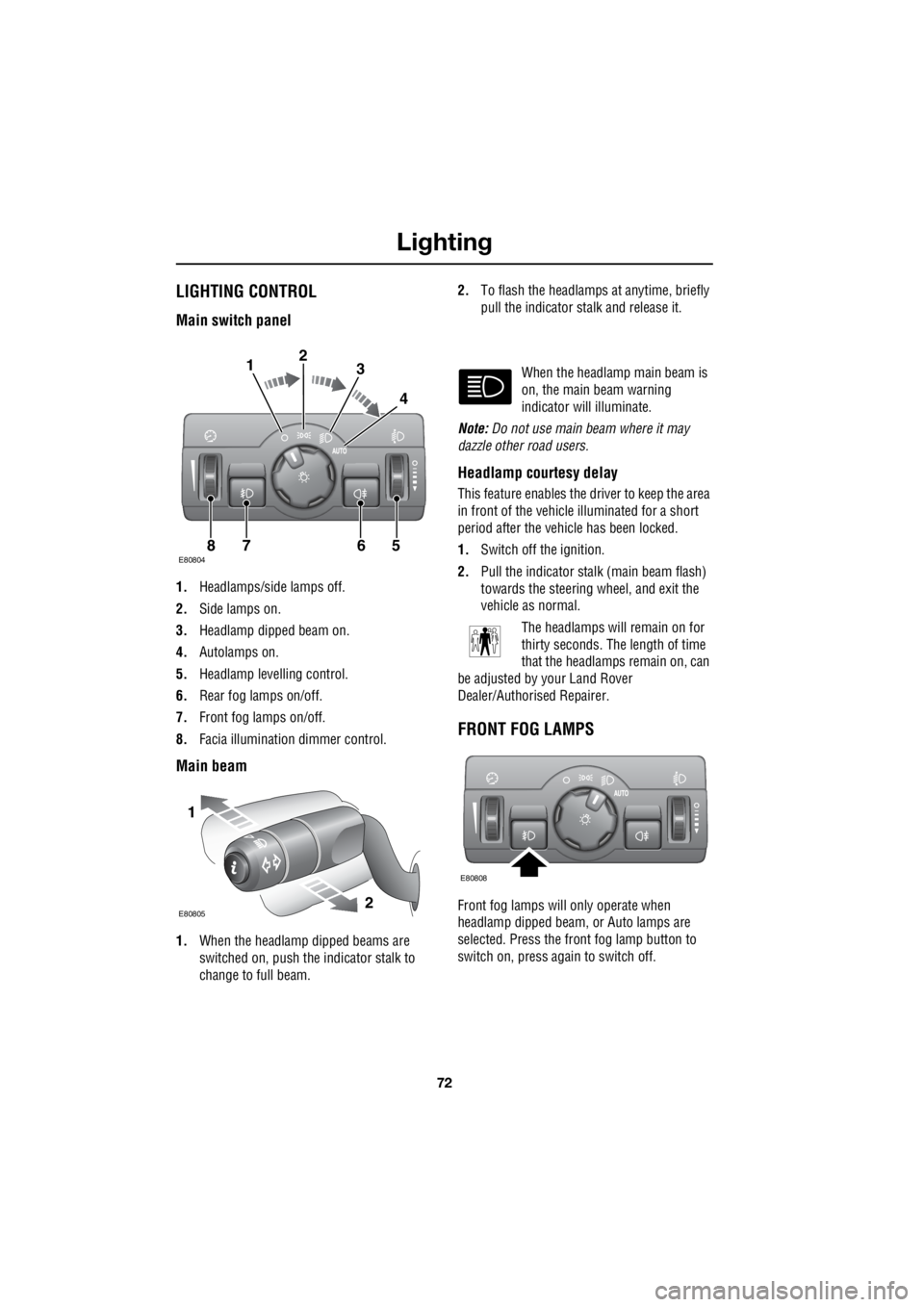
Lighting
72
L
LightingLIGHTING CONTROL
Main switch panel
1. Headlamps/side lamps off.
2. Side lamps on.
3. Headlamp dipped beam on.
4. Autolamps on.
5. Headlamp levelling control.
6. Rear fog lamps on/off.
7. Front fog lamps on/off.
8. Facia illumination dimmer control.
Main beam
1.When the headlamp dipped beams are
switched on, push the indicator stalk to
change to full beam. 2.
To flash the headlamps at anytime, briefly
pull the indicator stalk and release it.
When the headlamp main beam is
on, the main beam warning
indicator will illuminate.
Note: Do not use main beam where it may
dazzle other road users.
Headlamp courtesy delay
This feature enables the driver to keep the area
in front of the vehicle illuminated for a short
period after the vehicle has been locked.
1. Switch off the ignition.
2. Pull the indicator stalk (main beam flash)
towards the steering wheel, and exit the
vehicle as normal.
The headlamps will remain on for
thirty seconds. The length of time
that the headlamps remain on, can
be adjusted by your Land Rover
Dealer/Authorised Repairer.
FRONT FOG LAMPS
Front fog lamps will only operate when
headlamp dipped beam, or Auto lamps are
selected. Press the front fog lamp button to
switch on, press again to switch off.
E808047865
123
4
1
2E80805
E80808
Page 2794 of 3229
Lighting
74
L
HAZARD WARNING FLASHERS
Press the switch to turn the hazard warning
lamps on. When the hazard warning lamps are
operating, the indicator warning lamps will
flash in time with the hazard warning lamps.
Note: Hazard warning lamps can be used when
the ignition is on or off.
ADAPTIVE FRONT LIGHTING SYSTEM
(AFS)
1. Vehicle without AFS.
2. Vehicle with AFS.
When cornering using dipped beam, AFS will
adjust the headlamp beams to provide
improved illumination in the direction of travel.
AFS is deactivated when :-
• reverse gear is selected.
• the vehicle is stationary.
• daylight running lamps are on.
E80807
1
2
E80823
Page 2806 of 3229
Lighting
86
L
BULB SPECIFICATION CHART
CAUTION
Before attempting to replace a bulb,
ensure that both the affected lamp, and
the vehicle's ignition, are turned off. If
the circuit is live a s hort circuit can occur
which may damage the vehicle's electrical
system.
Lamp Specification Power (Watts)
Halogen headlamp (Dip and Main beam). H7 55
Xenon headlamp (Dip and Main beam). D1S 35
Front side lamps. W5W 5
Front direction i ndicators. PY21W 21
Rear direction i ndicators. PY21W 21
Front fog lamps. H11 55
Side repeater lamps. W5W 5
Reverse lamps. P21W 21
Rear fog lamps. P21W 21 Stop/tail lamps. P21/5W 21/5
High mounted stop lamp W16W 16 Number plate lamps. W5W 5 Puddle lamps. W5W 5
Interior lamps. W5W 5
Luggage/footwell lamps. W5W 5 Luggage/tailgate lamps. W5W 5
Glovebox lamp. W5W 5
Vanity mirror lamp. W5W 5
Page 2807 of 3229
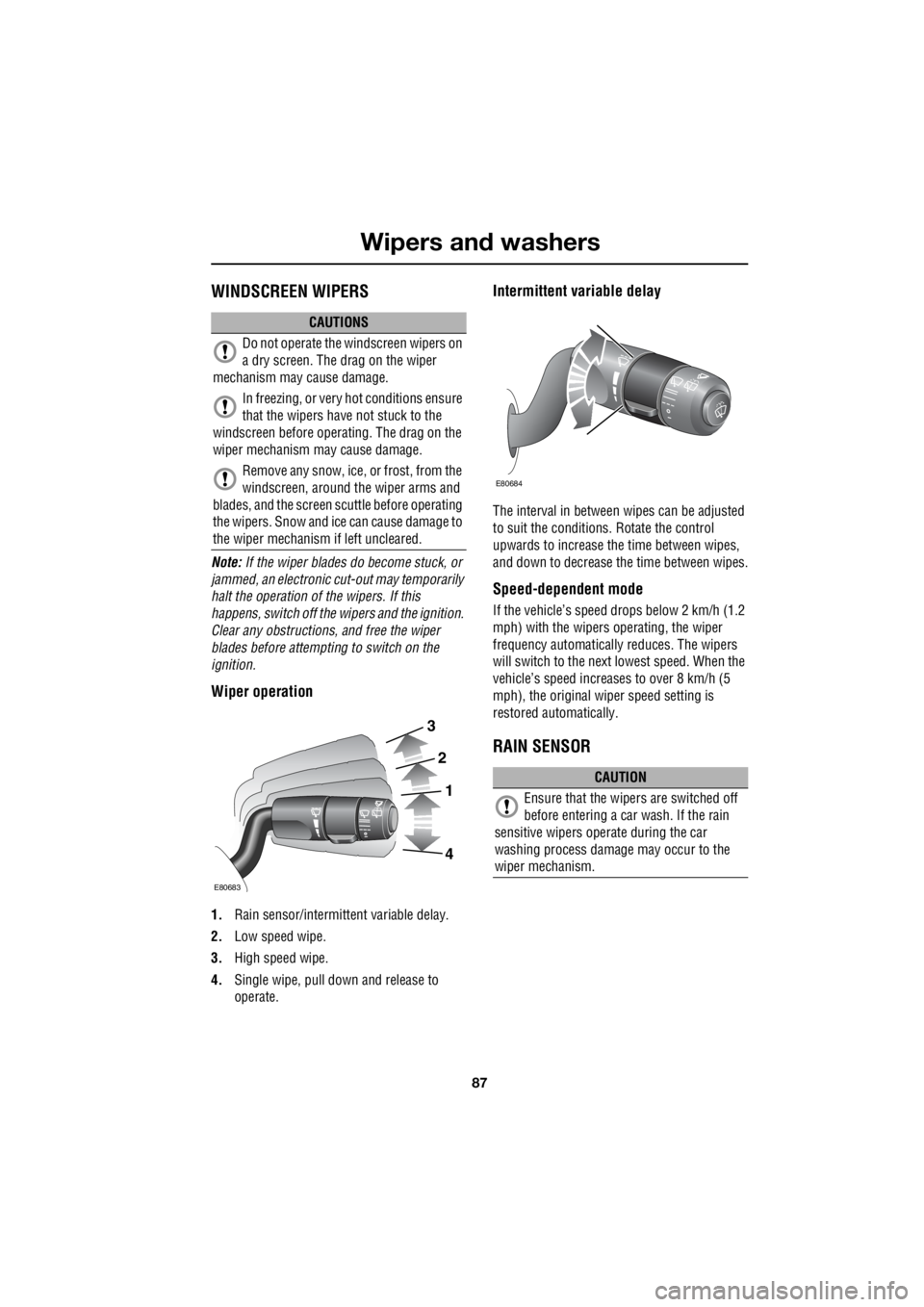
87
Wipers and washers
R
Wipers and washersWINDSCREEN WIPERS
Note: If the wiper blades do become stuck, or
jammed, an electronic cut-out may temporarily
halt the operation of the wipers. If this
happens, switch off the wipers and the ignition.
Clear any obstructions, and free the wiper
blades before attempting to switch on the
ignition.
Wiper operation
1. Rain sensor/intermitt ent variable delay.
2. Low speed wipe.
3. High speed wipe.
4. Single wipe, pull down and release to
operate.
Intermittent variable delay
The interval in between wipes can be adjusted
to suit the conditions. Rotate the control
upwards to increase th e time between wipes,
and down to decrease the time between wipes.
Speed-dependent mode
If the vehicle’s speed drops below 2 km/h (1.2
mph) with the wipers operating, the wiper
frequency automatically reduces. The wipers
will switch to the next lowest speed. When the
vehicle’s speed increases to over 8 km/h (5
mph), the original wiper speed setting is
restored automatically.
RAIN SENSOR
CAUTIONS
Do not operate the windscreen wipers on
a dry screen. The drag on the wiper
mechanism may cause damage.
In freezing, or very hot conditions ensure
that the wipers have not stuck to the
windscreen before operating. The drag on the
wiper mechanism ma y cause damage.
Remove any snow, ice, or frost, from the
windscreen, around the wiper arms and
blades, and the screen scuttle before operating
the wipers. Snow and ic e can cause damage to
the wiper mechanism if left uncleared.
3
2
1
4
E80683
CAUTION
Ensure that the wipers are switched off
before entering a car wash. If the rain
sensitive wipers ope rate during the car
washing process damage may occur to the
wiper mechanism.
E80684
Page 2808 of 3229
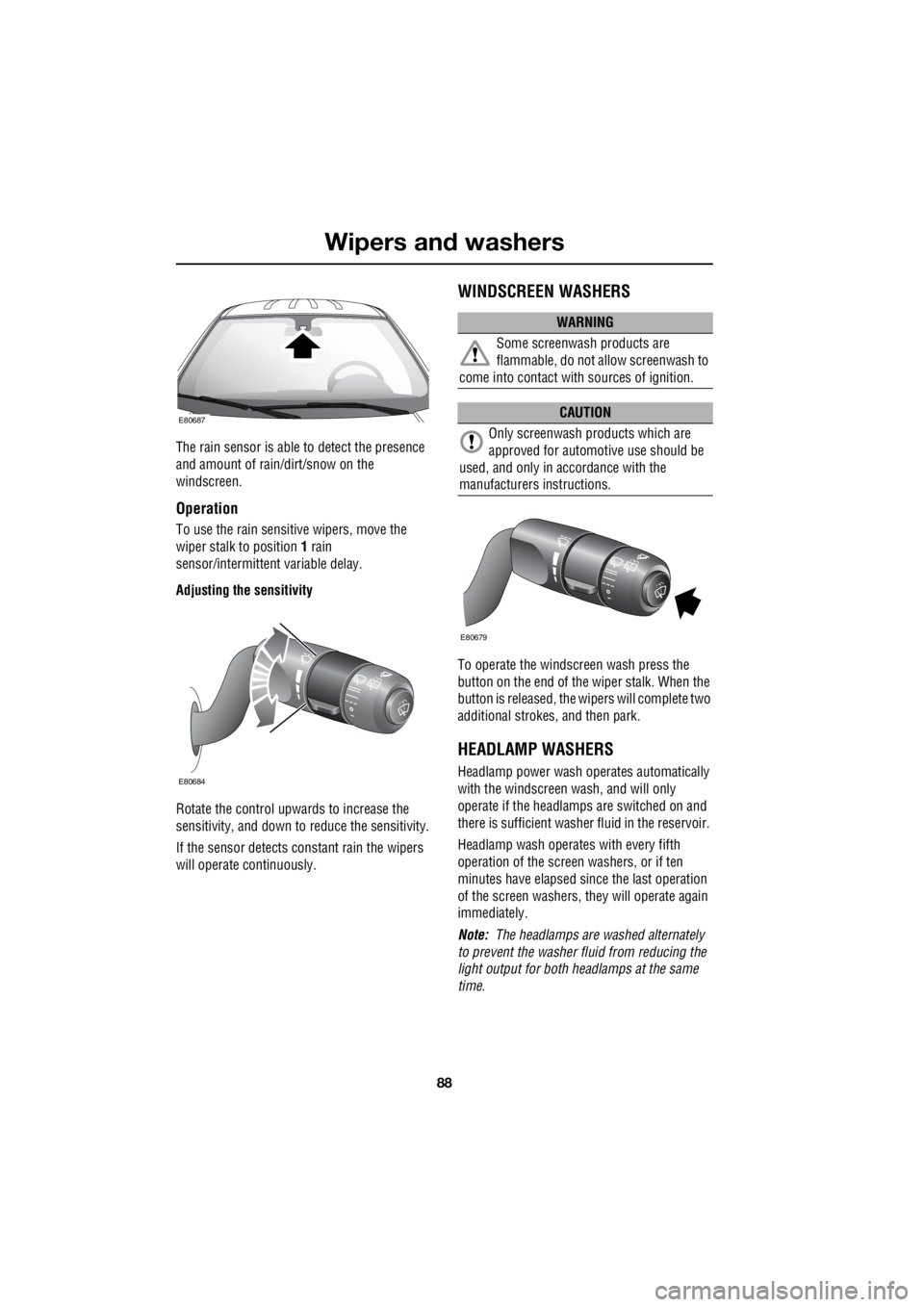
Wipers and washers
88
L
The rain sensor is able to detect the presence
and amount of rain/dirt/snow on the
windscreen.
Operation
To use the rain sensitive wipers, move the
wiper stalk to position 1 rain
sensor/intermittent variable delay.
Adjusting the sensitivity
Rotate the control upwards to increase the
sensitivity, and down to reduce the sensitivity.
If the sensor detects co nstant rain the wipers
will operate continuously.
WINDSCREEN WASHERS
To operate the windscreen wash press the
button on the end of the wiper stalk. When the
button is released, the wi pers will complete two
additional strokes, and then park.
HEADLAMP WASHERS
Headlamp power wash operates automatically
with the windscreen wash, and will only
operate if the headlamps are switched on and
there is sufficient washer fluid in the reservoir.
Headlamp wash operates with every fifth
operation of the screen washers, or if ten
minutes have elapsed si nce the last operation
of the screen washers, they will operate again
immediately.
Note: The headlamps are washed alternately
to prevent the washer fluid from reducing the
light output for both headlamps at the same
time.
E80687
E80684
WARNING
Some screenwash products are
flammable, do not allow screenwash to
come into contact with sources of ignition.
CAUTION
Only screenwash products which are
approved for automotive use should be
used, and only in accordance with the
manufacturers instructions.
E80679
Page 2810 of 3229
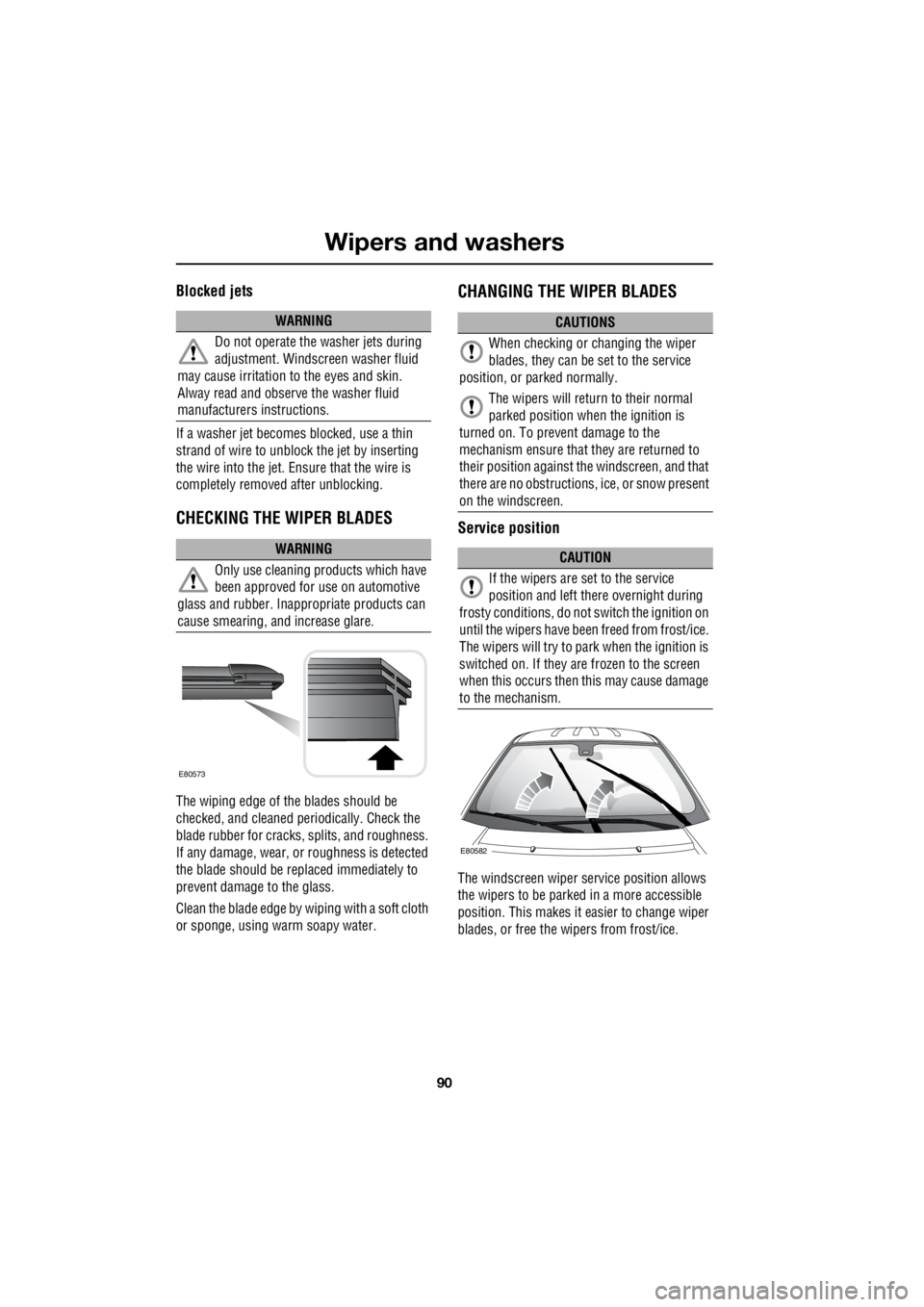
Wipers and washers
90
L
Blocked jets
If a washer jet becomes blocked, use a thin
strand of wire to unblock the jet by inserting
the wire into the jet. Ensure that the wire is
completely remove d after unblocking.
CHECKING THE WIPER BLADES
The wiping edge of the blades should be
checked, and cleaned pe riodically. Check the
blade rubber for cracks , splits, and roughness.
If any damage, wear, or roughness is detected
the blade should be repl aced immediately to
prevent damage to the glass.
Clean the blade edge by wiping with a soft cloth
or sponge, using warm soapy water.
CHANGING THE WIPER BLADES
Service position
The windscreen wiper se rvice position allows
the wipers to be parked in a more accessible
position. This makes it ea sier to change wiper
blades, or free the wipers from frost/ice.
WARNING
Do not operate the washer jets during
adjustment. Windscreen washer fluid
may cause irritation to the eyes and skin.
Alway read and observe the washer fluid
manufacturers instructions.
WARNING
Only use cleaning pr oducts which have
been approved for use on automotive
glass and rubber. Inappr opriate products can
cause smearing, and increase glare.
E80573
CAUTIONS
When checking or changing the wiper
blades, they can be set to the service
position, or parked normally.
The wipers will return to their normal
parked position when the ignition is
turned on. To prevent damage to the
mechanism ensure that they are returned to
their position against th e windscreen, and that
there are no obstructions, ice, or snow present
on the windscreen.
CAUTION
If the wipers are set to the service
position and left there overnight during
frosty conditions, do not switch the ignition on
until the wipers have been freed from frost/ice.
The wipers will try to park when the ignition is
switched on. If they are frozen to the screen
when this occurs then this may cause damage
to the mechanism.
E80582